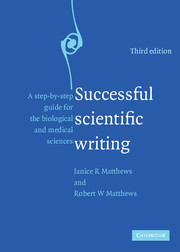Book contents
- Frontmatter
- Contents
- Preface
- Preface to the third edition
- 1 PREPARING TO WRITE
- 2 COMPOSING A FIRST DRAFT
- 3 VISUAL SUPPORT FOR THE WRITTEN WORD
- 4 VISUAL SUPPORT FOR THE SPOKEN WORD
- 5 REVISING TO INCREASE COHERENCE
- 6 IMPROVING WORD CHOICE, AND SYNTAX STYLE
- 7 ATTENDING TO GRAMMAR, NUMBERS, AND OTHER MECHANICS
- 8 THE REST OF THE STORY
- Appendix 1 Suggested responses to exercises
- Appendix 2 Excerpts from “Uniform requirements for manuscripts submitted to biomedical journals: Writing and editing for biomedical publication”
- Selected resources
- Index
7 - ATTENDING TO GRAMMAR, NUMBERS, AND OTHER MECHANICS
- Frontmatter
- Contents
- Preface
- Preface to the third edition
- 1 PREPARING TO WRITE
- 2 COMPOSING A FIRST DRAFT
- 3 VISUAL SUPPORT FOR THE WRITTEN WORD
- 4 VISUAL SUPPORT FOR THE SPOKEN WORD
- 5 REVISING TO INCREASE COHERENCE
- 6 IMPROVING WORD CHOICE, AND SYNTAX STYLE
- 7 ATTENDING TO GRAMMAR, NUMBERS, AND OTHER MECHANICS
- 8 THE REST OF THE STORY
- Appendix 1 Suggested responses to exercises
- Appendix 2 Excerpts from “Uniform requirements for manuscripts submitted to biomedical journals: Writing and editing for biomedical publication”
- Selected resources
- Index
Summary
Sticklers unite, you have nothing to lose but your sense of proportion, and arguably you didn't have a lot of that to begin with. Maybe we won't change the world, but at least we'll feel better.
– Lynne Truss (2003)Proper grammar, formatting, and citations are essential to effective written and oral communication. These fundamentals help avoid misunderstandings and reduce the chances of error in fact or interpretation.
Attention to detail is a little like housekeeping. When it is done well, no one is aware of it. When it is not, everyone can tell. If you skip this step, readers will notice. They may be willing to overlook small inconsistencies, but major blunders will distract their attention away from the primary purpose of the writing. No longer concentrating on the technical content, they start searching for more errors instead.
TWEAK THE TEXT
The difficulty is not to write, but to write what you mean.
– Robert Louis StevensonIf effective scientific communication is like a well designed and smoothly operating machine, then grammar – the accepted system of rules by which words are formed and put together to make sentences – forms the nuts and bolts that hold it all together. The individual fasteners of punctuation, capitalization, and such may seem simple and unexciting to look at, but they are undeniably important if the machine is to hold together and function properly.
In this section, we suggest ways of avoiding and correcting some common mechanical mistakes that scientific writers tend to make.
- Type
- Chapter
- Information
- Successful Scientific WritingA Step-by-Step Guide for the Biological and Medical Sciences, pp. 153 - 181Publisher: Cambridge University PressPrint publication year: 2007



